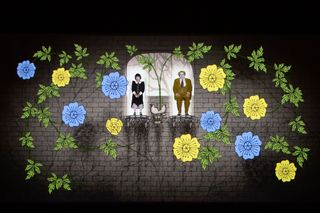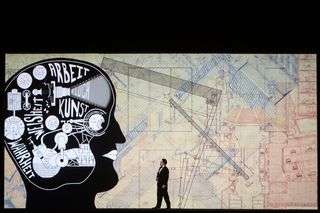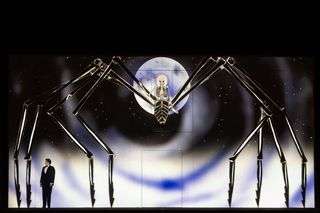|
Back
The Animated Mozart Houston
Brown Theater, Wortham Theater Center
02/04/2022 - and February 6*, 8, 10, 12, 13, 2022
Wolfgang Amadeus Mozart: Die Zauberflöte, K. 622
Norman Reinhardt (Tamino), Catilin Lynch (1st Lady), Sun-Ly Pierce (2nd Lady), Taylor Raven (3rd Lady), Thomas Glass (Papageno), Rainelle Krause (Queen of the Night), Aaron Pegram (Monostatos), Andrea Carroll (Pamina), Alexis Medina (1st Spirit), Ella Clark Theurer (2nd Spirit), Liam Norton (3rd Spirit), Anthony Robin Schneider (Sarastro), Raven McMillon (Papagena)
Houston Grand Opera Orchestra and Chorus, Dame Jane Glover (conductor)
Erik Friedman (revival director), Barrie Kosky (original co-director), Suzanne Andrade (original co-director), Esther Bialas (set and costume designer), Michael James Clark and Jennifer Tipton (lighting designers) 
A. Carroll, T. Glass (© Lynn Lane)
It was an immense pleasure to return to the Wortham Center after over two years to Barrie Kosky and Suzanne Andrade’s renowned version of The Magic Flute. The extravagant visualization of Mozart’s timeless Singspiel was premiered in late 2012—pre-pandemic, pre-Trump, pre-Brexit—in Berlin, and one wonders if audiences’ reactions then were spellbound but perhaps a bit naive. Without surveying reviews of the time for comparison, I get a sense that Kosky’s Edward Gorey-inspired production, laden with sinister undertones, might come across as slightly more disturbing now than it did then.
It is interesting to note that HGO presented Flute in 2015, also in a modernized production, but one that, I suspect, would feel remarkably similar if revived today. That it’s taken nearly a decade for the Kosky/Andrade Flute to reach Houston is a result of both its global demand and the pandemic (it was intended for Spring 2020). Regardless, experiencing the current run live is a must for Houston audiences.
Mozart’s famous overture, shaky at the outset but increasingly impressive as Dame Jane Glover’s propulsive account went on, led to the revelation of the fantasy-world that would delight our eyes for the next two hours. Gorey-inspired, tantalizingly grotesque black-and-white illustrations, steampunk fashion and pre-World War II Berlin cabaret stylings were synthesized in a constantly whirring animated background against which (or perhaps “with which”) the cast performed. Intricately timed animations combined with the live performers’ motions and words to enhance the plot of the opera. Everything fit together like clockwork.

N. Reinhardt (© Lynn Lane)
Likewise, the singing in the production is nearly flawless. Norman Reinhardt’s announced head cold didn’t prevent him from presenting a nuanced and thoughtfully-sung Tamino. Rainelle Krause, in her HGO debut, sang the Queen of the Night’s first aria with a bit of reserve and then unleashed vocal daggers (mirrored in animation) for “Der Hölle Rache,” eliciting the compulsory ovations from the audience.
As impressive as Krause was, it was Andrea Carroll’s Tamina that stole the show. She brought vocal purity and agility to “Ach ich fühl’s”, with caressed phrases and grief-filled portamenti that were literally spine-tingling. In ensemble numbers, she carried effortlessly. I only remember her in small roles when she was in the HGO studio, and it is wonderful to see her development into a star. Thomas Glass’ Papageno was also exquisite. Andrade declares Papageno “the most sympathetic and interesting character in the whole opera,” and Glass visually and vocally dominates nearly every scene he’s in.

Rainelle Krause(©Lynn Lane )
There are a few strange choices in the production, including the washed-out yellow costume chosen for Papagena (delightfully sung by Raven McMillon). The color story of the entire production is so well thought out that this hue’s appearance seemed erroneous. Kosky and Andrade’s decision to replace Emanuel Schikaneder’s spoken dialogue with silent-film style projections and fortepiano snippets essentially takes the opera out of the Singspiel genre of which it is considered the epitome. At times, the live performers seem constricted by the mechanics of the production. These are all tiny nits to pick, and in the end, the evening is thoroughly entertaining, operatically fulfilling and magically original.
Marcus Karl Maroney
|